Molecular and Stable Isotope Composition of Pollutants Emitted during Thermal Processes within the Rymer Coal Waste Dump (Upper Silesia, Poland)
Abstract
:1. Introduction
2. Materials and Methods
2.1. Materials
2.1.1. Gas Samples
2.1.2. Rock Samples
2.2. Methods
2.2.1. Gas Samples
2.2.2. Rock Samples
Rock-Eval Pyrolysis
Stepwise Pyrolysis in Py-GC-MS
3. Results
3.1. Gas Samples
3.1.1. Molecular Composition
3.1.2. Isotopic Composition
3.2. Rock Samples
3.2.1. Rock-Eval Data
3.2.2. Py-GC-MS
4. Discussion
4.1. Evaluation of Pollutants Released during Self-Heating Using Rock-Eval and Py-GC-MS
4.2. Origin of Emitted Gases
4.3. Changes in Pollutants Type Released during the Development of the Self-Heating Process
5. Conclusions
- (i)
- TOC content in coal wastes is high, from 7.3 to 27.2 wt.%, whereas subsurface layers are richer than surface one. For surface samples, higher PI values than for subsurface samples were recorded, identifying deposition on surface tars and bitumen migrated from self-heating spots.
- (ii)
- Alkanes, BTX, PAHs and aromatic alcohols are the main products of the thermal decomposition of coal wastes, and the main phase of this process occurs at 350–650 °C, indicating that this temperature regime is responsible for the generation of most of the organic pollutants. These components migrate upwards and precipitate on the surface of the dump and were recorded in pyrolysis products of samples collected from landfill surface.
- (iii)
- In addition to high-molecular-weight organic compounds, the products of self-heating are CO2, CO, hydrocarbons (mainly CH4) and sulphur compounds (mainly H2S). The stable isotope composition indicates that methane is mainly related to the thermal decomposition of organic matter, but some part of this gas is microbial-originated. CO2 and CO are products of organic matter or generated hydrocarbons oxidation, but a part of CO (and also H2) may originate from the reaction of burning coal with water (moisture), resulting in syngas generation. The S-compounds (H2S, COS and thiols) detected in soil gases are the result of mainly thermal decomposition of sulphides and organic S-compounds present in coal wastes. The BTX’s also occur in soil gases as products of organic matter pyrolysis and burning in oxygen-depleted conditions.
- (iv)
- The sampling survey along the delineated profile made it possible to study the variation of waste temperature and gaseous contaminants in soil gases over time. Hydrocarbon and CO contents are good indicators of self-heating processes, while sulphur compounds, due to their low concentrations and susceptibility to dissolution in water and adsorption, are not a good indicator of changes in these processes.
Supplementary Materials
Author Contributions
Funding
Acknowledgments
Conflicts of Interest
References
- Skarżyńska, K.M. Reuse of coal mining wastes in civil engineering—Part 1: Properties of minestone. Waste Manag. 1995, 15, 3–42. [Google Scholar] [CrossRef]
- Misz-Kennan, M.; Fabiańska, M. Thermal transformation of organic matter in coal waste from Rymer Cones (Upper Silesian Coal Basin, Poland). Int. J. Coal Geol. 2010, 81, 343–358. [Google Scholar] [CrossRef]
- Querol, X.; Izquierdo, M.; Monfort, E.; Alvarez, E.; Font, O.; Moreno, T.; Alastuey, A.; Zhuang, X.; Lu, W.; Wang, Y. Environmental characterization of burnt coal gangue banks at Yangquan, Shanxi Province, China. Int. J. Coal Geol. 2008, 75, 93–104. [Google Scholar] [CrossRef]
- Ribeiro, J.; da Silva, E.F.; Flores, D. Burning of coal waste piles from Douro Coalfield (Portugal): Petrological, geochemical and mineralogical characterization. Int. J. Coal Geol. 2010, 81, 359–372. [Google Scholar] [CrossRef]
- Misz-Kennan, M. Thermal alterations of organic matter in coal wastes from Upper Silesia, Poland. Mineralogia 2010, 41, 105–236. [Google Scholar] [CrossRef]
- Skrȩt, U.; Fabiańska, M.J.; Misz-Kennan, M. Simulated water-washing of organic compounds from self-heated coal wastes of the Rymer Cones Dump (Upper Silesia Coal Region, Poland). Org. Geochem. 2010, 41, 1009–1012. [Google Scholar] [CrossRef]
- Misz-Kennan, M.; Tabor, A. The Thermal History of Select Coal-Waste Dumps in the Upper Silesian Coal Basin, Poland. In Coal and Peat Fires: A Global Perspective; Stracher, G.B., Sokol, E.V., Prakash, A., Eds.; Elsevier: Amsterdam, The Netherlands, 2015; pp. 431–462. [Google Scholar]
- Nádudvari, Á.; Abramowicz, A.; Fabiańska, M.; Misz-Kennan, M.; Ciesielczuk, J. Classification of fires in coal waste dumps based on Landsat, Aster thermal bands and thermal camera in Polish and Ukrainian mining regions. Int. J. Coal Sci. Technol. 2021, 8, 441–456. [Google Scholar] [CrossRef]
- Nádudvari, Á.; Ciesielczuk, J. Remote Sensing Techniques for Detecting Self-Heated Hot Spots on Coal Waste Dumps in Upper Silesia, Poland. In Coal and Peat Fires: A Global Perspective; Stracher, G.B., Ed.; Elsevier: Amsterdam, The Netherlands, 2019; pp. 387–406. ISBN 978-0-12-849885-9. [Google Scholar]
- Kruszewski, Ł.; Fabiańska, M.J.; Ciesielczuk, J.; Segit, T.; Orłowski, R.; Motyliński, R.; Kusy, D.; Moszumańska, I. First multi-tool exploration of a gas-condensate-pyrolysate system from the environment of burning coal mine heaps: An in situ FTIR and laboratory GC and PXRD study based on Upper Silesian materials. Sci. Total Environ. 2018, 640–641, 1044–1071. [Google Scholar] [CrossRef]
- Kruszewski, Ł.; Fabiańska, M.J.; Segit, T.; Kusy, D.; Motyliński, R.; Ciesielczuk, J.; Deput, E. Carbon-nitrogen compounds, alcohols, mercaptans, monoterpenes, acetates, aldehydes, ketones, SF6, PH3, and other fire gases in coal-mining waste heaps of Upper Silesian Coal Basin (Poland)—A re-investigation by means of in situ FTIR external database ap. Sci. Total Environ. 2020, 698, 134274. [Google Scholar] [CrossRef]
- Fabiańska, M.; Ciesielczuk, J.; Nádudvari, Á.; Misz-Kennan, M.; Kowalski, A.; Kruszewski, Ł. Environmental influence of gaseous emissions from self-heating coal waste dumps in Silesia, Poland. Environ. Geochem. Health 2019, 41, 575–601. [Google Scholar] [CrossRef] [Green Version]
- Więcław, D.; Jurek, K.J.; Kowalski, A.; Fabiańska, M.J.; Ciesielczuk, J.; Misz-Kennan, M.; Nádudvari, Á. Dependence of the molecular composition of the gas emitted during self-ignition processes on the temperature in the coal waste dump: Example from Upper Silesia, Poland. In Proceedings of the Energy, Fuels, Environment Conference, Kraków, Poland, 16–18 September 2020. [Google Scholar]
- Fabiańska, M.J.; Nádudvari, Á.; Ciesielczuk, J.; Szram, E.; Misz-Kennan, M.; Więcław, D. Organic contaminants of coal-waste dump water in the Lower- and Upper Silesian Coal Basins (Poland). Appl. Geochem. 2020, 122, 104690. [Google Scholar] [CrossRef]
- Nádudvari, Á.; Fabiańska, M.J.; Misz-Kennan, M.; Ciesielczuk, J.; Kowalski, A. Investigation of organic material self-heating in oxygen-depleted condition within a coal-waste dump in Upper Silesia Coal Basin, Poland. Environ. Sci. Pollut. Res. 2020, 27, 8285–8307. [Google Scholar] [CrossRef]
- Waliczek, M.; Machowski, G.; Więcław, D.; Konon, A.; Wandycz, P. Properties of solid bitumen and other organic matter from Oligocene shales of the Fore-Magura Unit in Polish Outer Carpathians: Microscopic and geochemical approach. Int. J. Coal Geol. 2019, 210, 103206. [Google Scholar] [CrossRef]
- Zielińska, M.; Fabiańska, M.J.; Więcław, D.; Misz-Kennan, M. Comparative petrography and organic geochemistry of different types of organic matter occurring in the Outer Carpathians rocks. Geol. Q. 2020, 64, 165–184. [Google Scholar] [CrossRef] [Green Version]
- Lafargue, E.; Marquis, F.; Pillot, D. Rock-Eval 6 applications in hydrocarbon exploration, production, and soil contamination studies. Rev. Inst. Fr. Pet. 1998, 53, 421–437. [Google Scholar] [CrossRef] [Green Version]
- Behar, F.; Beaumont, V.; De B. Penteado, H.L. Rock-Eval 6 Technology: Performances and Developments. Oil Gas Sci. Technol. 2001, 56, 111–134. [Google Scholar] [CrossRef]
- Dahl, B.; Bojesen-Koefoed, J.; Holm, A.; Justwan, H.; Rasmussen, E.; Thomsen, E. A new approach to interpreting Rock-Eval S2 and TOC data for kerogen quality assessment. Org. Geochem. 2004, 35, 1461–1477. [Google Scholar] [CrossRef]
- Więcław, D. Habitat and hydrocarbon potential of the Kimmeridgian strata in the central part of the Polish Lowlands. Geol. Q. 2016, 60, 192–210. [Google Scholar] [CrossRef] [Green Version]
- Kotarba, M.J.; Więcław, D.; Bilkiewicz, E.; Dziadzio, P.; Kowalski, A. Genetic correlation of source rocks and natural gas in the Polish Outer Carpathians and Paleozoic-Mesozoic basement east of Kraków (Southern Poland). Geol. Q. 2017, 61, 795–824. [Google Scholar] [CrossRef] [Green Version]
- Baudin, F.; Disnar, J.-R.; Aboussou, A.; Savignac, F. Guidelines for Rock–Eval analysis of recent marine sediments. Org. Geochem. 2015, 86, 71–80. [Google Scholar] [CrossRef] [Green Version]
- Carrie, J.; Sanei, H.; Stern, G. Standardisation of Rock–Eval pyrolysis for the analysis of recent sediments and soils. Org. Geochem. 2012, 46, 38–53. [Google Scholar] [CrossRef]
- Hetényi, M.; Nyilas, T. Soil Organic Matter Characterization Using S3 and S4 Signals from Rock-Eval Pyrolysis. Pedosphere 2014, 24, 563–574. [Google Scholar] [CrossRef]
- Więcław, D.; Sadlik, M. Evaluation of ground pollution by hydrocarbons using Rock-Eval pyrolysis. Pol. J. Chem. Technol. 2019, 21, 8–12. [Google Scholar] [CrossRef] [Green Version]
- Peters, K.E.; Cassa, M.R. Applied Source-Rock Geochemistry. In The Petroleum System. From Source to Trap, AAPG Memoir; Magoon, L.B., Dow, W.G., Eds.; AAPG: Tulsa, OK, USA, 1994; pp. 93–120. [Google Scholar]
- Pone, J.D.N.; Hein, K.A.A.; Stracher, G.B.; Annegarn, H.J.; Finkleman, R.B.; Blake, D.R.; McCormack, J.K.; Schroeder, P. The spontaneous combustion of coal and its by-products in the Witbank and Sasolburg coalfields of South Africa. Int. J. Coal Geol. 2007, 72, 124–140. [Google Scholar] [CrossRef]
- Kruszewski, Ł. Burning Coal-Mining Heaps as an Organochemical Laboratory: Interesting Trace Compounds and their Potential Sources. In Organic Compounds; Open Access eBooks: Las Vegas, NV, USA, 2021; p. 38. ISBN 978-93-87500-41-9. [Google Scholar]
- Kotarba, M.J. Composition and origin of coalbed gases in the Upper Silesian and Lublin basins, Poland. Org. Geochem. 2001, 32, 163–180. [Google Scholar] [CrossRef]
- Kotarba, M.J.; Lewan, M.D. Characterizing thermogenic coalbed gas from Polish coals of different ranks by hydrous pyrolysis. Org. Geochem. 2004, 35, 615–646. [Google Scholar] [CrossRef]
- Lewan, M.D.; Kotarba, M.J. Thermal-maturity limit for primary thermogenic-gas generation from humic coals as determined by hydrous pyrolysis. Am. Assoc. Pet. Geol. Bull. 2014, 98, 2581–2610. [Google Scholar] [CrossRef]
- Kotarba, M.J.; Pluta, I. Origin of natural waters and gases within the Upper Carboniferous coal-bearing and autochthonous Miocene strata in South-Western part of the Upper Silesian Coal Basin, Poland. Appl. Geochem. 2009, 24, 876–889. [Google Scholar] [CrossRef]
- Kędzior, S.; Kotarba, M.J.; Pękała, Z. Geology, spatial distribution of methane content and origin of coalbed gases in Upper Carboniferous (Upper Mississippian and Pennsylvanian) strata in the south-eastern part of the Upper Silesian Coal Basin, Poland. Int. J. Coal Geol. 2013, 105, 24–35. [Google Scholar] [CrossRef]
- Sechman, H.; Kotarba, M.J.; Kędzior, S.; Dzieniewicz, M.; Romanowski, T.; Twaróg, A. Distribution of methane and carbon dioxide concentrations in the near-surface zone, genetic implications, and evaluation of gas flux around abandoned shafts in the Jastrzębie-Pszczyna area (southern part of the Upper Silesian Coal Basin, Poland). Int. J. Coal Geol. 2019, 204, 51–69. [Google Scholar] [CrossRef]
- Sechman, H.; Kotarba, M.J.; Kędzior, S.; Kochman, A.; Twaróg, A. Fluctuations in methane and carbon dioxide concentrations in the near-surface zone and their genetic characterization in abandoned and active coal mines in the SW part of the Upper Silesian Coal Basin, Poland. Int. J. Coal Geol. 2020, 227, 103529. [Google Scholar] [CrossRef]
- Milkov, A.V.; Etiope, G. Revised genetic diagrams for natural gases based on a global dataset of >20,000 samples. Org. Geochem. 2018, 125, 109–120. [Google Scholar] [CrossRef]
- Chung, H.M.; Gormly, J.R.; Squires, R.M. Origin of gaseous hydrocarbons in subsurface environments: Theoretical considerations of carbon isotope distribution. Chem. Geol. 1988, 71, 97–104. [Google Scholar] [CrossRef]
- Gustalo, L.K.; Plotnikov, A.M. Carbon isotopic composition in the CH4-CO2 system as a criterion for the origin of methane and carbon dioxide in Earth natural gases. Dokl. Akad. Nauk SSSR 1981, 259, 470–473. (In Russian) [Google Scholar]
- Milkov, A.V. Worldwide distribution and significance of secondary microbial methane formed during petroleum biodegradation in conventional reservoirs. Org. Geochem. 2011, 42, 184–207. [Google Scholar] [CrossRef]
- Kotarba, M.J. Geochemical criteria for the origin of natural gases accumulated in the Upper Carboniferous coal-seam-bearing formation in Wałbrzych coal basin. Geology 1988, 42, 1–119, (In Polish with English Abstract). [Google Scholar]
- Kotarba, M.J.; Bilkiewicz, E.; Jurek, K.J.; Waliczek, M.; Więcław, D.; Zych, H. Thermogenic gases generated from coals and carbonaceous shales of the Upper Silesian and Lublin Coal Basins: Hydrous pyrolysis approach. Geol. Q. 2021, 65, 26–65. [Google Scholar] [CrossRef]
- Fabiańska, M.J.; Ciesielczuk, J.; Kruszewski, Ł.; Misz-Kennan, M.; Blake, D.R.; Stracher, G.; Moszumańska, I. Gaseous compounds and efflorescences generated in self-heating coal-waste dumps—A case study from the Upper and Lower Silesian Coal Basins (Poland). Int. J. Coal Geol. 2013, 116–117, 247–261. [Google Scholar] [CrossRef]


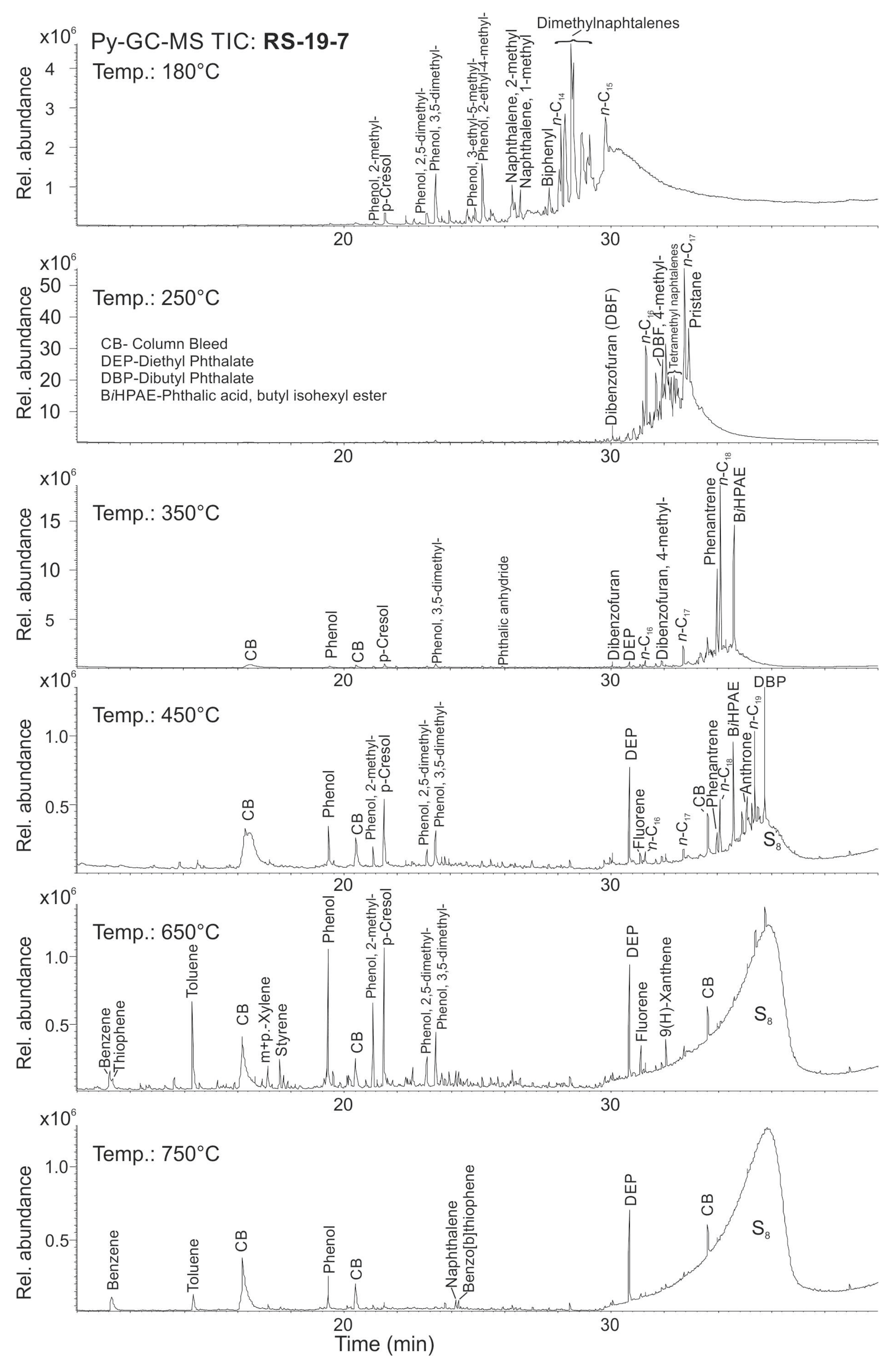
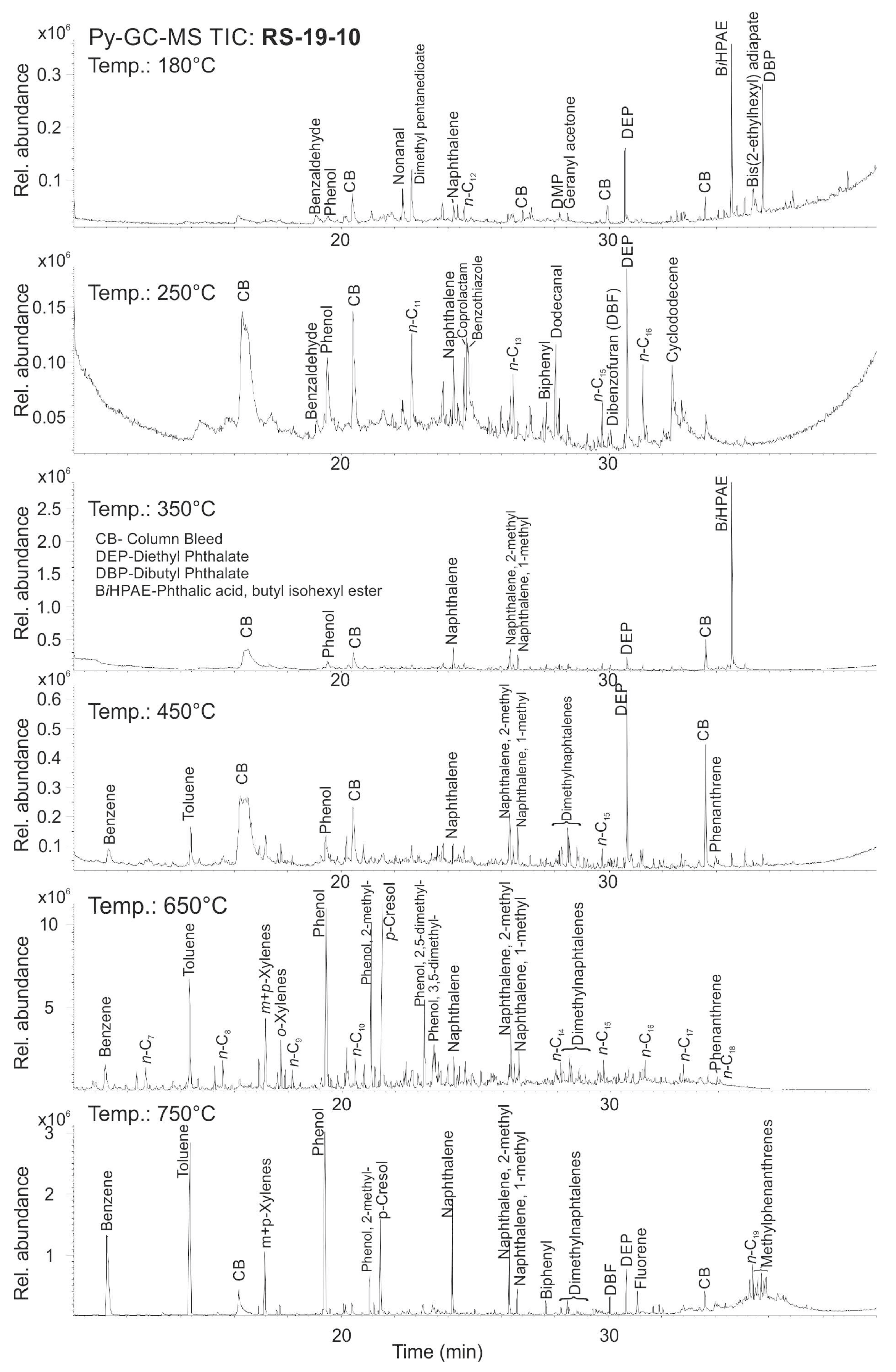
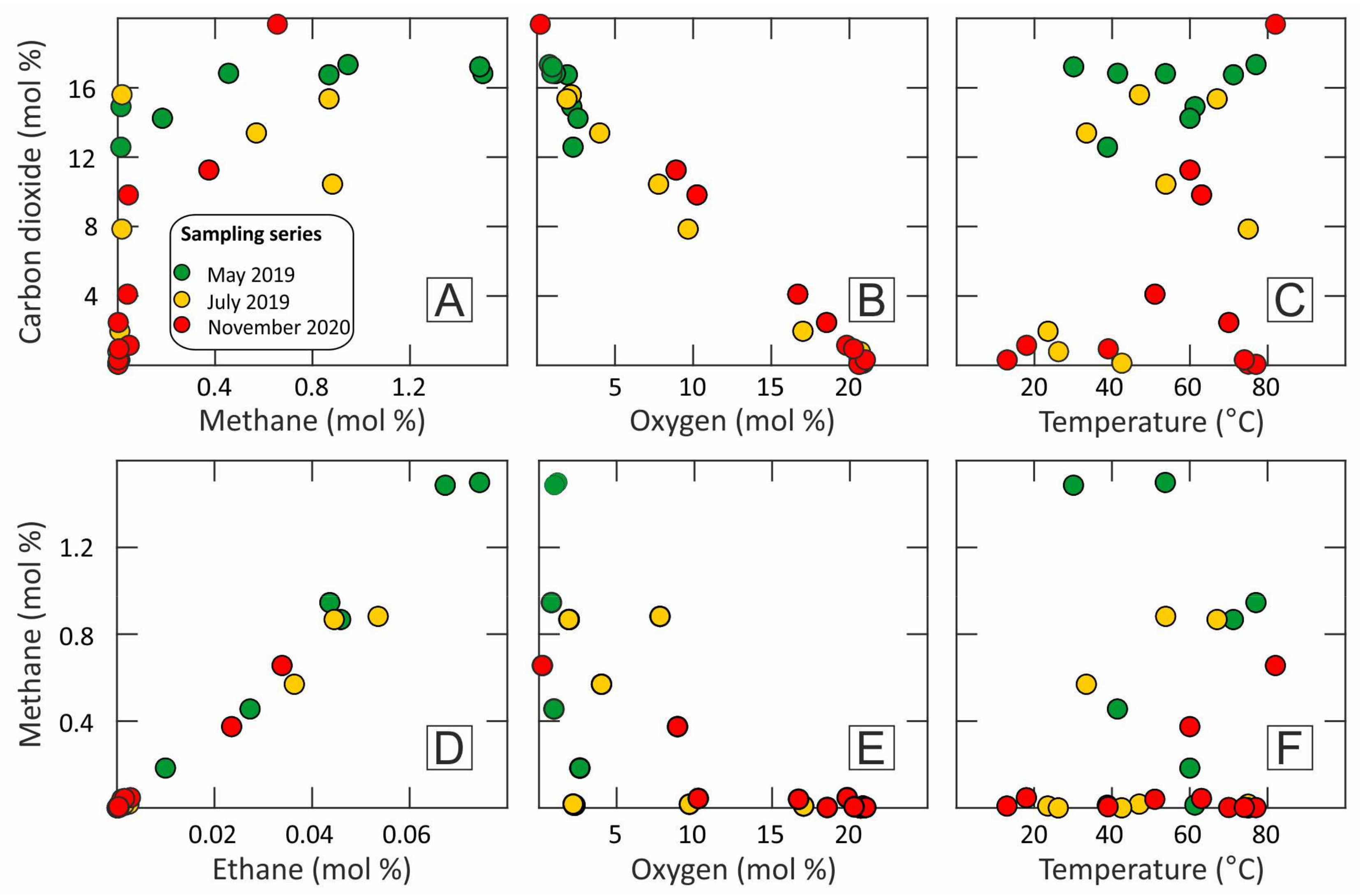
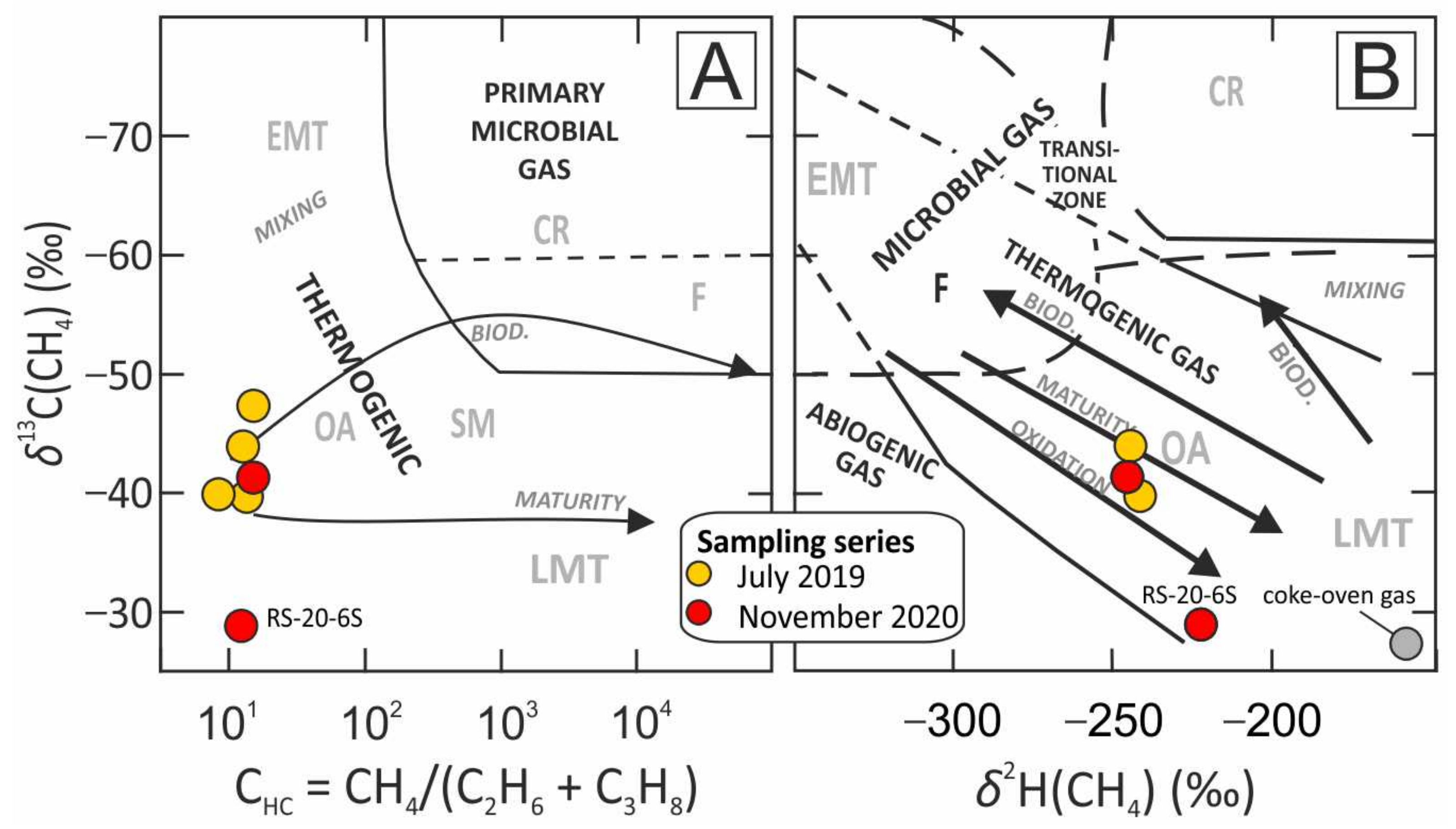
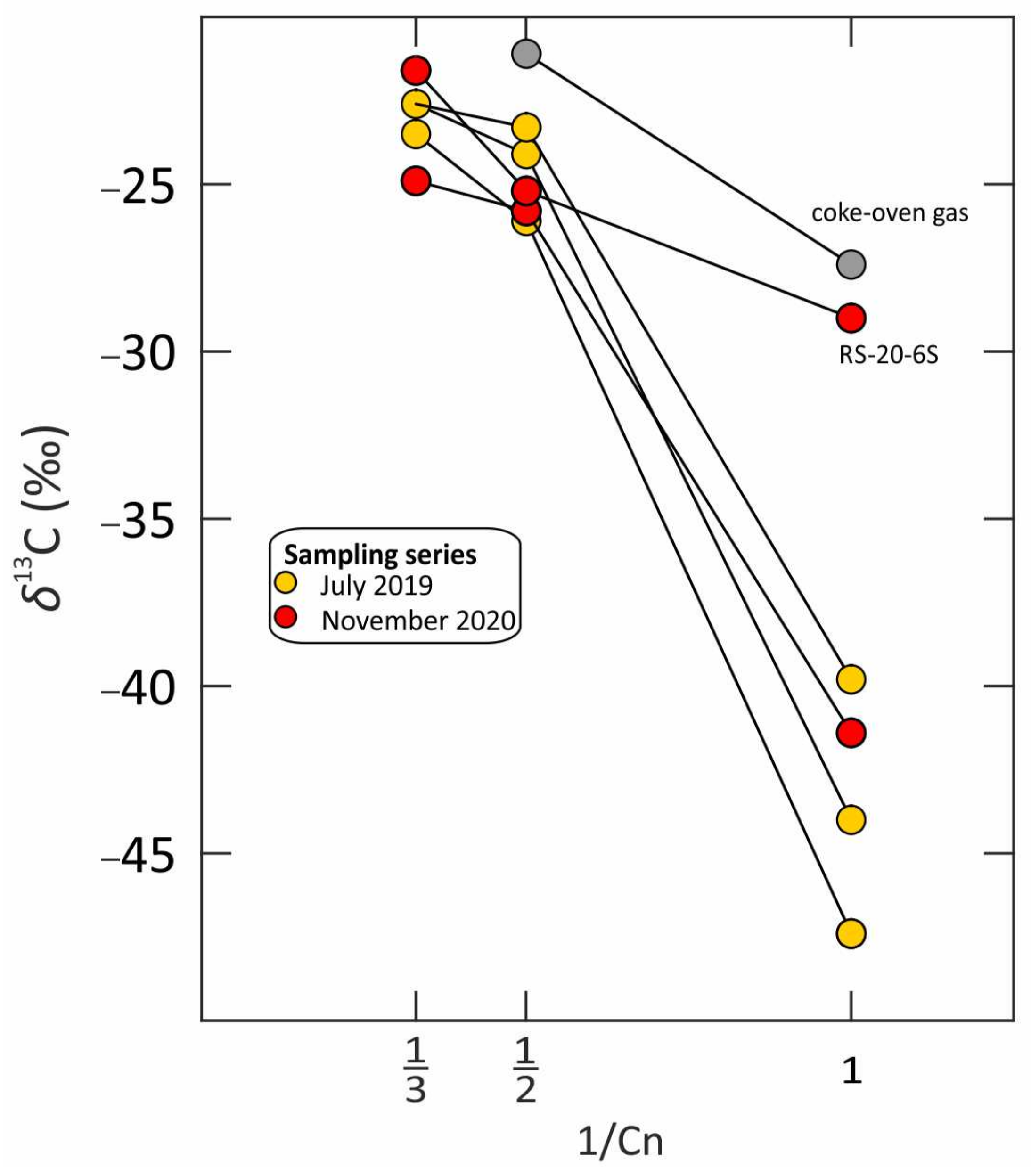
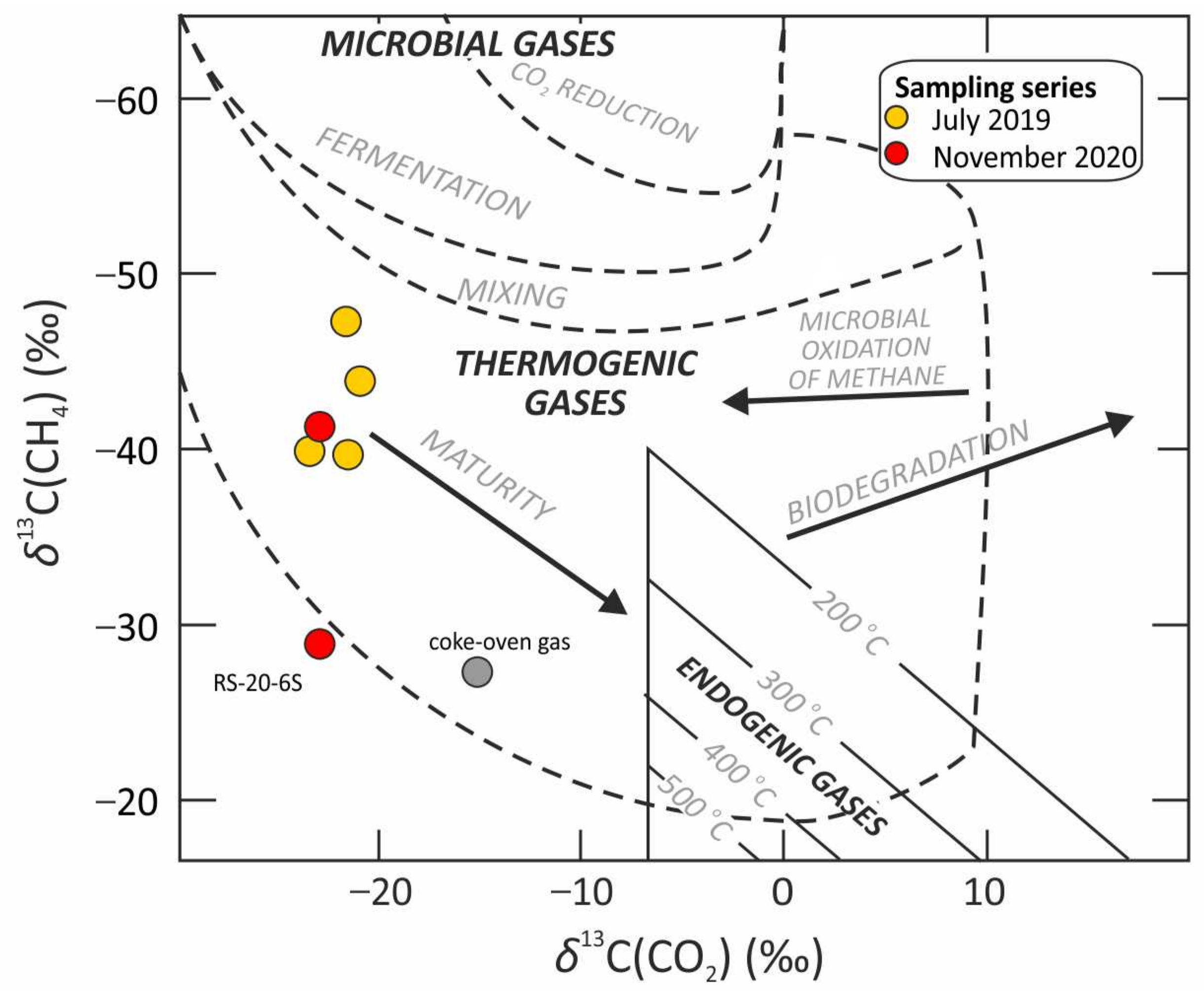
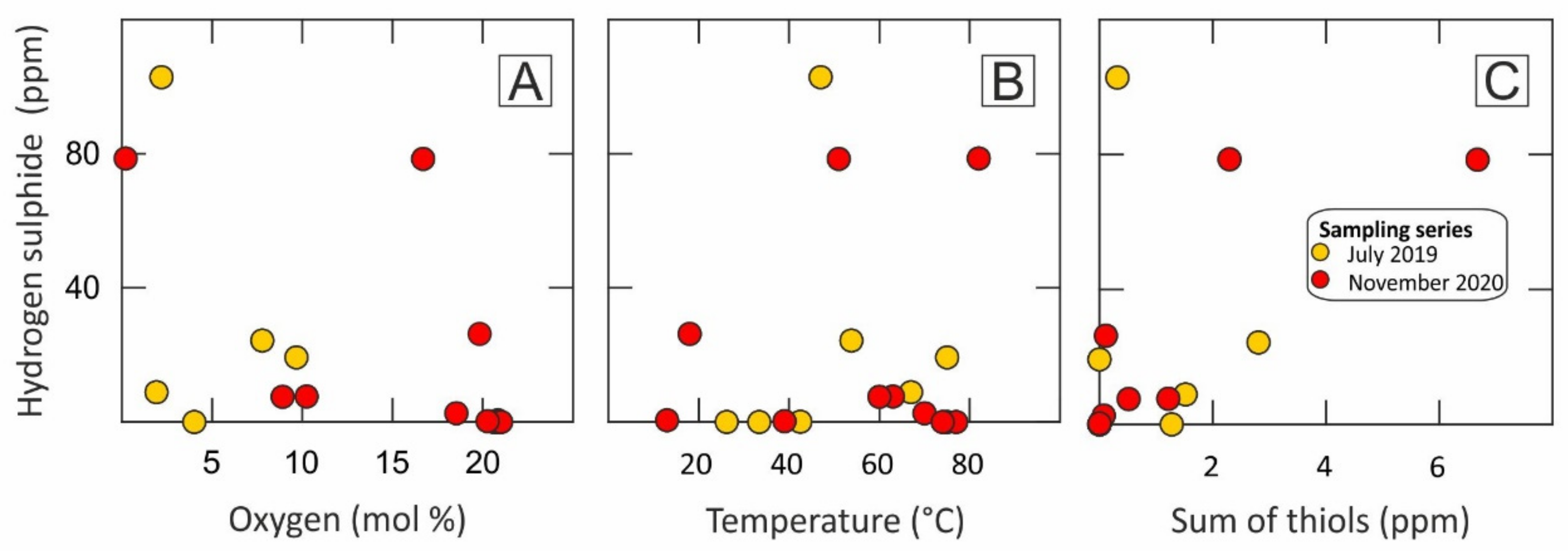
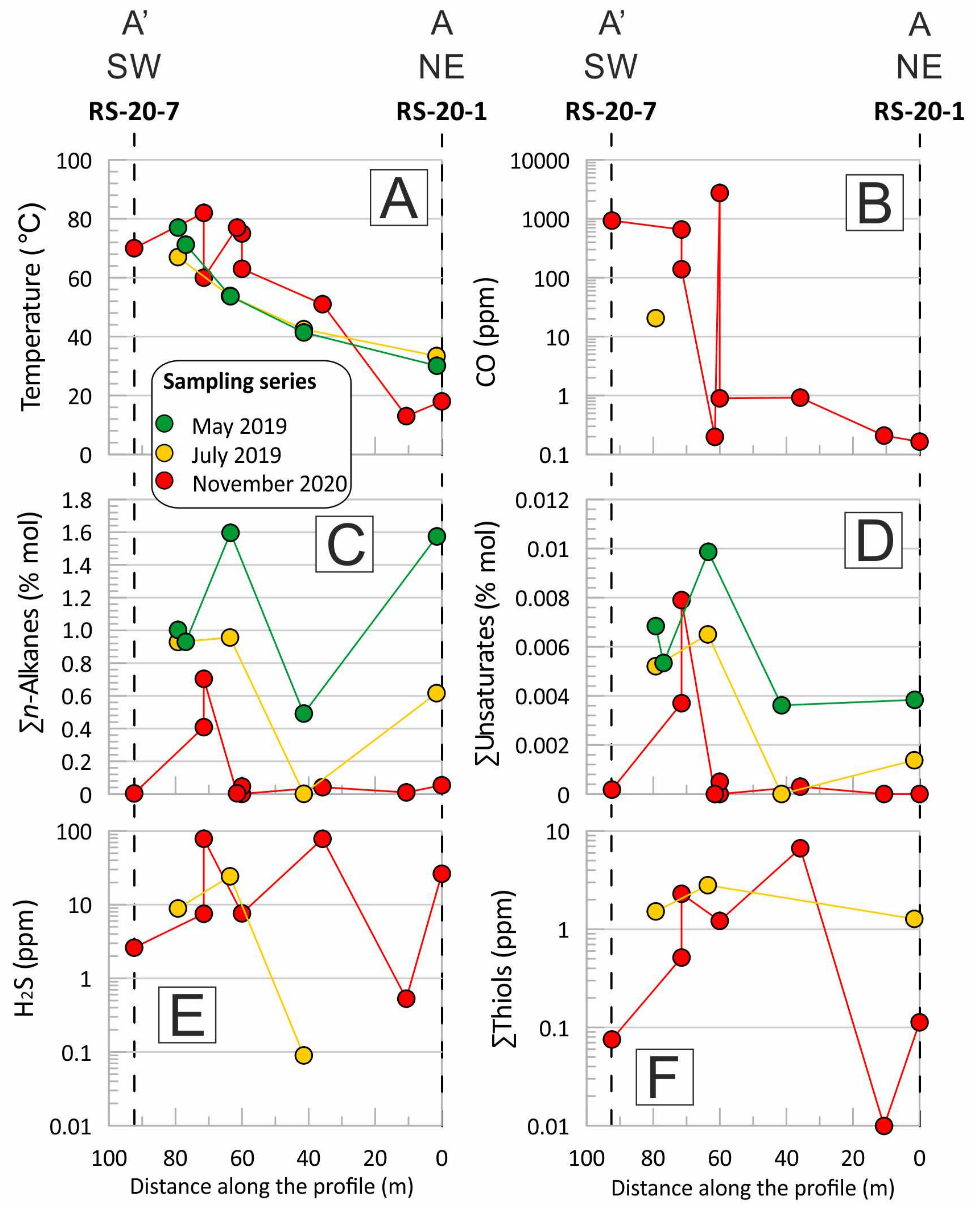
| Sample Code | Latitude (N) | Longitude (E) | Temperature Measurement Depth (m) | Temperature at Depth (°C) | Gas Sample Depth (m) | Rock Sample Depth (m) | Sampling Date |
|---|---|---|---|---|---|---|---|
| RS-19-1 | 50.055379 | 18.493659 | 0.20 | 77 | 0.80 | surface | 21 May 2019 |
| RS-19-2 | 50.055355 | 18.493713 | 0.20 | 71 | 0.45 | surface | 21 May 2019 |
| RS-19-3 | 50.055433 | 18.493869 | 0.20 | 54 | 1.00 | surface | 21 May 2019 |
| RS-19-4 | 50.055612 | 18.494045 | 0.20 | 41 | 0.90 | surface | 21 May 2019 |
| RS-19-5 | 50.055829 | 18.494504 | 0.20 | 30 | 0.70 | surface | 21 May 2019 |
| RS-19-6 | 50.056737 | 18.494960 | 0.20 | 61 | 0.70 | surface | 21 May 2019 |
| RS-19-7 | 50.056790 | 18.495111 | 0.20 | 60 | 0.60 | surface | 21 May 2019 |
| RS-19-8 | 50.056888 | 18.494973 | 0.17 | 39 | 0.90 | n.s. | 21 May 2019 |
| RS-19-9 | 50.055243 | 18.493972 | 0.15 | 24 | 1.00 | 0.15 | 23 July 2019 |
| RS-19-10 | 50.055054 | 18.493767 | 0.15 | 26 | 0.50 | 0.15 | 23 July 2019 |
| RS-19-11 | 50.056055 | 18.492717 | 0.15 | 47 | 0.50 | 0.15 | 23 July 2019 |
| RS-19-12 | 50.055379 | 18.493659 | 0.15 | 67 | 0.60 | 0.15 | 23 July 2019 |
| RS-19-13 | 50.055433 | 18.493869 | 0.15 | 54 | 0.80 | 0.15 | 23 July 2019 |
| RS-19-14 | 50.055612 | 18.494045 | 0.15 | 43 | 0.60 | 0.15 | 23 July 2019 |
| RS-19-15 | 50.055829 | 18.494504 | 0.15 | 33 | 0.90 | 0.15 | 23 July 2019 |
| RS-19-16 | 50.056737 | 18.494960 | 0.15 | 75 | 0.90 | n.s. | 23 July 2019 |
| RS-20-1 | 50.055811 | 18.494454 | 0.50 | 18 | 0.50 | n.s. | 26 November 2020 |
| RS-20-2 | 50.055772 | 18.494386 | 0.50 | 13 | 0.30 | n.s. | 26 November 2020 |
| RS-20-3 | 50.055628 | 18.494122 | 0.70 | 51 | 0.70 | n.s. | 26 November 2020 |
| RS-20-4D | 50.055492 | 18.493858 | 0.50 | 75 | 0.50 | n.s. | 26 November 2020 |
| RS-20-4S | 50.055492 | 18.493858 | surface | 63 | surface | n.s. | 26 November 2020 |
| RS-20-5 | 50.055472 | 18.493861 | 1.00 | 77 | 1.00 | n.s. | 26 November 2020 |
| RS-20-6D | 50.055417 | 18.493750 | 0.70 | 82 | 1.10 | n.s. | 26 November 2020 |
| RS-20-6S | 50.055417 | 18.493750 | surface | 60 | surface | n.s. | 26 November 2020 |
| RS-20-7 | 50.055400 | 18.493412 | 0.50 | 70 | 0.45 | n.s. | 26 November 2020 |
| RS-20-8 | 50.056062 | 18.492804 | 1.00 | 74 | 0.65 | n.s. | 26 November 2020 |
| RS-20-9 | 50.055980 | 18.492469 | 1.00 | 39 | 0.80 | n.s. | 26 November 2020 |
| Sample Code | CHC | C1/C2+ | CO × 100/CO2 | CO/Σ(C1–C7) | H2 × 100/CO2 | ΣS-Comp. (ppm) | ΣPAH (ppm) | CDMI | CDHI |
|---|---|---|---|---|---|---|---|---|---|
| RS-19-1 | 17.2 | 14.4 | n.a. | n.a. | 0.19 | n.a. | n.a. | 94.8 | 94.5 |
| RS-19-2 | 14.9 | 12.2 | n.a. | n.a. | 0.21 | n.a. | n.a. | 95.1 | 94.7 |
| RS-19-3 | 16.1 | 13.6 | n.a. | n.a. | 0.24 | n.a. | n.a. | 91.8 | 91.3 |
| RS-19-4 | 13.2 | 10.9 | n.a. | n.a. | 0.03 | n.a. | n.a. | 97.4 | 97.1 |
| RS-19-5 | 17.7 | 15.7 | n.a. | n.a. | 0.01 | n.a. | n.a. | 92.0 | 91.6 |
| RS-19-6 | 6.1 | 2.2 | n.a. | n.a. | 0.27 | n.a. | n.a. | 99.9 | 99.9 |
| RS-19-7 | 15.1 | 6.8 | n.a. | n.a. | 0.59 | n.a. | n.a. | 98.7 | 98.5 |
| RS-19-8 | 23.2 | 7.5 | n.a. | n.a. | 0.02 | n.a. | n.a. | 99.9 | 99.9 |
| RS-19-9 | 6.0 | 1.5 | n.a. | n.a. | 0.00 | n.a. | n.a. | 99.5 | 99.3 |
| RS-19-10 | 1.4 | 0.2 | 0.00 | 0.00 | 0.00 | 0.02 | n.a. | 100.0 | 99.7 |
| RS-19-11 | 5.5 | 3.0 | 0.06 | 0.43 | 0.41 | 107.04 | n.a. | 99.9 | 99.8 |
| RS-19-12 | 15.2 | 12.5 | 0.01 | 0.002 | 0.11 | 11.05 | n.a. | 94.7 | 94.2 |
| RS-19-13 | 12.7 | 10.5 | n.a. | n.a. | 0.06 | 27.10 | n.a. | 92.2 | 91.5 |
| RS-19-14 | 1.3 | 0.6 | n.a. | n.a. | 0.00 | 0.09 | n.a. | 99.5 | 98.8 |
| RS-19-15 | 13.6 | 10.8 | 0.00 | 0.00 | 0.00 | 1.27 | n.a. | 95.9 | 95.6 |
| RS-19-16 | 8.4 | 5.5 | 3.19 | 12.23 | 7.57 | 19.67 | n.a. | 99.8 | 99.7 |
| RS-20-1 | 10.5 | 6.3 | <0.01 | <0.001 | 0.04 | 26.38 | 0.46 | 96.1 | 95.5 |
| RS-20-2 | 15.4 | 7.0 | <0.01 | <0.001 | 0.00 | 0.67 | 0.26 | 97.3 | 96.9 |
| RS-20-3 | 30.8 | 18.2 | <0.01 | <0.001 | 0.09 | 85.11 | 6.23 | 99.0 | 99.0 |
| RS-20-4D | 8.2 | 0.9 | <0.01 | <0.001 | 0.23 | 0.08 | 0.47 | 99.3 | 98.6 |
| RS-20-4S | 22.9 | 15.0 | 2.79 | 5.89 | 0.82 | 12.23 | 13.38 | 99.6 | 99.5 |
| RS-20-5 | 1.7 | 0.6 | <0.01 | <0.001 | 0.44 | 0.09 | 0.27 | 97.0 | 92.4 |
| RS-20-6D | 15.1 | 10.6 | 0.07 | 0.02 | 4.09 | 82.77 | 124.00 | 96.8 | 96.5 |
| RS-20-6S | 12.3 | 9.1 | 0.58 | 0.16 | 5.77 | 8.34 | 104.95 | 96.8 | 96.4 |
| RS-20-7 | 4.8 | 1.0 | 3.77 | 21.54 | 0.57 | 3.66 | 3.04 | 99.9 | 99.8 |
| RS-20-8 | 13.1 | 1.8 | 2.90 | 2.21 | 1.15 | 0.17 | 0.55 | 99.2 | 98.7 |
| RS-20-9 | 12.0 | 5.2 | 0.10 | 0.14 | 1.58 | 0.44 | 0.78 | 99.4 | 99.3 |
| Sample Code | δ13C | δ2H | δ13C | δ13C | δ13C | Δ13C (C2−C1) | Δ13C (C3−C2) | Δ13C (CH4−CO2) |
|---|---|---|---|---|---|---|---|---|
| (CH4) | (CH4) | (C2H6) | (C3H8) | (CO2) | ||||
| RS-19-9 | n.a. | n.a. | n.a. | n.a. | −19.2 | n.a. | n.a. | n.a. |
| RS-19-10 | n.a. | n.a. | n.a. | n.a. | −20.7 | n.a. | n.a. | n.a. |
| RS-19-11 | n.a. | n.a. | n.a. | n.a. | −22.3 | n.a. | n.a. | n.a. |
| RS-19-12 | −47.4 | n.a. | −26.1 | −23.5 | −21.7 | 21.3 | 2.6 | −25.7 |
| RS-19-13 | −44.0 | −245 | −24.1 | −22.6 | −21.0 | 19.9 | 1.5 | −23.0 |
| RS-19-14 | −n.a. | n.a. | n.a. | n.a. | −28.4 | n.a. | n.a. | n.a. |
| RS-19-15 | −39.8 | −242 | −23.3 | −22.6 | −21.6 | 16.5 | 0.7 | −18.2 |
| RS-19-16 | −40.0 | n.a. | n.a. | n.a. | −23.5 | n.a. | n.a. | −16.5 |
| RS-20-6D | −41.4 | −246 | −25.8 | −24.9 | −23.0 | 15.6 | 0.9 | −18.4 |
| RS-20-6S | −29.0 | −223 | −25.2 | −21.6 | −23.0 | 3.8 | 3.6 | −6.0 |
| coke-oven gas | −27.4 | −159 | −21.1 | n.a. | −15.2 | 6.3 | n.a. | −12.2 |
| Sample | Sampling | Depth | TOC | Tmax | S1 | S2 | PI | HI | OI | MINC |
|---|---|---|---|---|---|---|---|---|---|---|
| Serie | (m) | (wt.%) | (oC) | (wt.%) | ||||||
| RS-19-1 | May 2019 | surface | 16.8 | 436 | 1.89 | 15.3 | 0.11 | 91 | 8 | 0.69 |
| RS-19-2 | May 2019 | surface | 9.8 | 432 | 6.6 | 8.2 | 0.45 | 84 | 25 | 0.57 |
| RS-19-3 | May 2019 | surface | 15.9 | 436 | 23.8 | 9.9 | 0.71 | 63 | 15 | 0.96 |
| RS-19-4 | May 2019 | surface | 10.1 | 436 | 13.1 | 5.7 | 0.70 | 56 | 4 | 0.55 |
| RS-19-5 | May 2019 | surface | 8.7 | 436 | 0.69 | 6.9 | 0.09 | 80 | 25 | 0.92 |
| RS-19-6 | May 2019 | surface | 22.2 | 326 | 99.1 | 11.0 | 0.90 | 49 | 73 | 2.76 |
| RS-19-7 | May 2019 | surface | 11.4 | 310 | 95.9 | 0.56 | 0.99 | 5 | 44 | 3.87 |
| RS-19-9 | July 2019 | 0.15 | 7.3 | 434 | 0.07 | 6.4 | 0.01 | 87 | 132 | 1.31 |
| RS-19-10 | July 2019 | 0.15 | 24.2 | 430 | 0.68 | 23.1 | 0.03 | 95 | 84 | 2.34 |
| RS-19-11 | July 2019 | 0.15 | 23.2 | 427 | 46.5 | 32.5 | 0.59 | 140 | 21 | 2.35 |
| RS-19-12 | July 2019 | 0.15 | 25.6 | 430 | 5.1 | 31.6 | 0.14 | 123 | 31 | 2.13 |
| RS-19-13 | July 2019 | 0.15 | 28.6 | 431 | 21.6 | 33.7 | 0.39 | 118 | 23 | 2.60 |
| RS-19-14 | July 2019 | 0.15 | 10.3 | 430 | 2.8 | 9.6 | 0.22 | 93 | 59 | 1.28 |
| RS-19-15 | July 2019 | 0.15 | 27.2 | 427 | 3.0 | 29.7 | 0.09 | 109 | 91 | 2.79 |
| Fraction | Q0 | Q1 | Q2 | Q3 | Q4 | Q5 | QT |
|---|---|---|---|---|---|---|---|
| Temperature Interval (°C) | <100 | 100–180 | 180–250 | 250–350 | 350–450 | 450–650 | |
| RS-19-6 | 1.0 | 79.0 | 40.6 | 10.7 | 7.1 | 2.0 | 140.4 |
| RS-19-7 | 2.8 | 111.7 | 35.8 | 0.7 | 0.1 | 0.2 | 151.3 |
| RS-19-10 | 0.01 | 0.03 | 0.05 | 0.24 | 5.6 | 6.1 | 12.0 |
Publisher’s Note: MDPI stays neutral with regard to jurisdictional claims in published maps and institutional affiliations. |
© 2021 by the authors. Licensee MDPI, Basel, Switzerland. This article is an open access article distributed under the terms and conditions of the Creative Commons Attribution (CC BY) license (https://creativecommons.org/licenses/by/4.0/).
Share and Cite
Więcław, D.; Jurek, K.; Fabiańska, M.J.; Bilkiewicz, E.; Kowalski, A.; Misz-Kennan, M.; Ciesielczuk, J. Molecular and Stable Isotope Composition of Pollutants Emitted during Thermal Processes within the Rymer Coal Waste Dump (Upper Silesia, Poland). Minerals 2021, 11, 1120. https://doi.org/10.3390/min11101120
Więcław D, Jurek K, Fabiańska MJ, Bilkiewicz E, Kowalski A, Misz-Kennan M, Ciesielczuk J. Molecular and Stable Isotope Composition of Pollutants Emitted during Thermal Processes within the Rymer Coal Waste Dump (Upper Silesia, Poland). Minerals. 2021; 11(10):1120. https://doi.org/10.3390/min11101120
Chicago/Turabian StyleWięcław, Dariusz, Krzysztof Jurek, Monika J. Fabiańska, Elżbieta Bilkiewicz, Adam Kowalski, Magdalena Misz-Kennan, and Justyna Ciesielczuk. 2021. "Molecular and Stable Isotope Composition of Pollutants Emitted during Thermal Processes within the Rymer Coal Waste Dump (Upper Silesia, Poland)" Minerals 11, no. 10: 1120. https://doi.org/10.3390/min11101120






